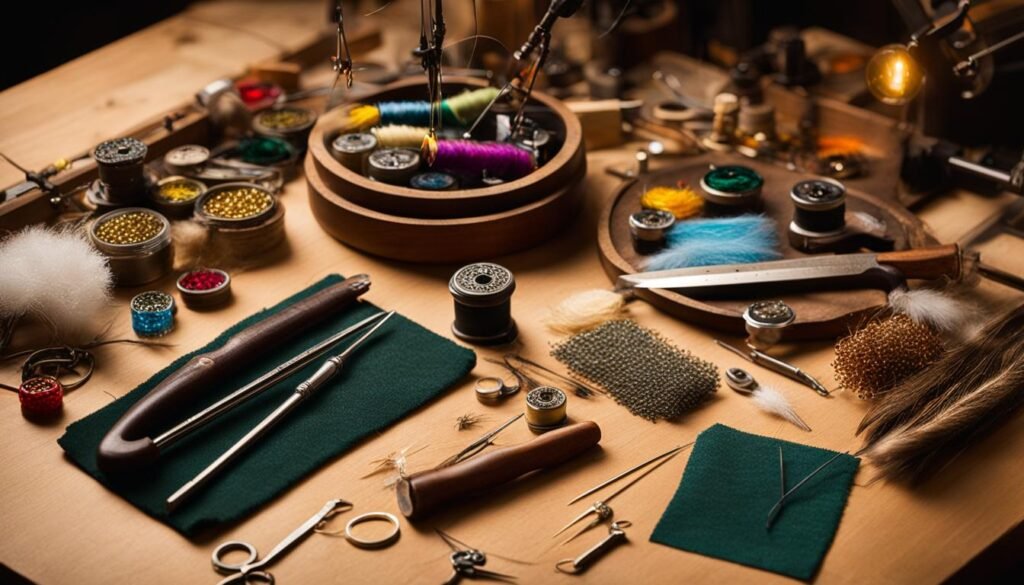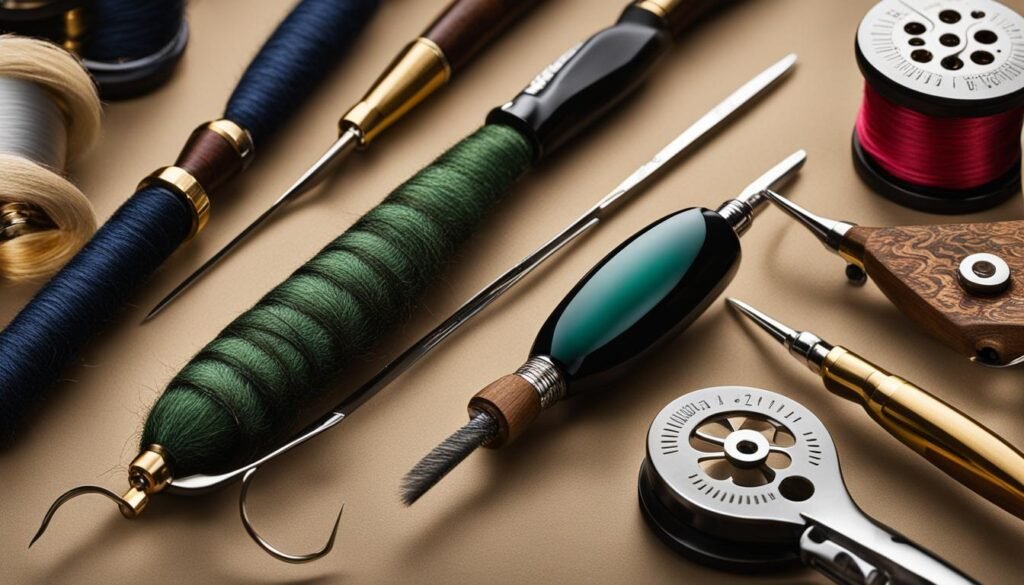Fly tying is a popular pastime that requires a set of essential tools. Whether you are a seasoned angler or just starting out, having the right fly tying tools is crucial for achieving fly tying success. In this article, I will guide you through the best fly tying tools, so you can create beautiful and effective flies that will attract the fish you desire.
DISCLAIMER: The links I mention may be affiliate links. If you purchase through one of these links I may receive a commission, at no cost to you. As an Amazon Associate I earn from qualifying purchases.
The Vise – The Foundation of Fly Tying
When it comes to fly tying, the vise is the cornerstone of the craft. It securely holds the hook in place, allowing you to tie your fly with precision and ease. When selecting a vise, there are a few key factors to consider.
Firstly, think about your budget. While there are high-end vises available, you don’t need to break the bank when starting out. There are plenty of affordable options that will serve you well.
Next, consider where you’ll be tying your flies. If you have a dedicated tying bench, a C-clamp vise that attaches to the edge of a table might be the best choice. On the other hand, if you plan to tie flies on the go or at different locations, a pedestal vise that can be used on any surface is a versatile option.
Another important factor is the size of the hooks you’ll be using. Make sure the vise you choose can accommodate the hook sizes you plan to tie. Some vises have adjustable jaws that can handle a wide range of hook sizes, while others are designed for specific sizes or ranges.
Fly Tying Vise Comparison
| Vise Type | Pros | Cons |
|---|---|---|
| C-Clamp Vise | Sturdy attachment to table edge | Requires a table or bench |
| Pedestal Vise | Can be used on any surface | Less stable than C-clamp vise |
The Riverruns Rotary Fly Typing Vise is a great option for anyone looking for a vise that can be mounted to a table or work bench.
The Bryon Rotary Fly Vise is a brilliant choice if you want a vise that is more portable and doesn’t use a clamp.
The Bobbin – Your Connection to the Thread
A bobbin is an essential tool in fly tying as it serves as the connection between the spool of thread and the hook. When choosing a bobbin, there are various factors to consider to ensure smooth and efficient tying. One important feature to look for is an adjustable tension system, which allows you to control the tension of the thread as you tie. This feature ensures that the thread stays secure while also allowing for flexibility and adjustment based on the materials being used.
Another aspect to consider is the ergonomic design of the bobbin. Fly tying sessions can be lengthy, and having a bobbin that feels comfortable in your hand can make a big difference in your overall tying experience. Look for a bobbin with an ergonomic handle that provides a firm grip and minimizes hand fatigue.
It’s worth noting that a bobbin threader is a useful tool for threading the tying thread through the bobbin, especially when working with fine threads or when the bobbin is tightly wound. However, it’s not an essential tool and can be substituted with alternative methods such as using dental floss threaders or simply moistening the thread and pinching it to a point for easier threading.
Comparison of Different Bobbin Types
| Bobbin Type | Adjustable Tension | Ergonomic Design | Bobbin Threader Included |
|---|---|---|---|
| Standard Bobbin | No | No | No |
| Adjustable Tension Bobbin | Yes | No | No |
| Ergonomic Bobbin | No | Yes | No |
| Ultimate Bobbin | Yes | Yes | Yes |
Scissors – The Key to Precise Fly Tying

When it comes to fly tying, having the right scissors is essential for achieving precision in your flies. Whether you’re trimming materials, cutting threads, or shaping wings, fine point scissors are a must-have tool in your fly tying kit. Fine point scissors allow for intricate cuts and precise trimming, ensuring that your flies look neat and professional.
But it’s not just about having the right type of scissors; it’s also important to invest in a quality pair. Dull scissors can make cutting materials more difficult and result in messy fly patterns. To maintain the sharpness of your scissors, regular blade sharpening is recommended. This will keep the blades in optimal condition, allowing for clean and effortless cuts.
In addition to fine point scissors, it can be useful to have wire cutters in your arsenal. Wire cutters are handy for trimming heavy wire or lead-free wires that can dull your fine point scissors quickly. By having a separate pair of wire cutters, you can preserve the sharpness of your fine point scissors for delicate materials.
Fly Tying Whip Finishing Tool – Perfecting Your Fly’s Finish
When it comes to fly tying, one of the essential tools that every angler needs is a whip finishing tool. This specialized tool is used to tie off the thread and create a clean and secure finish for your flies. While it is possible to accomplish a whip finish by hand, using a dedicated tool can make the process easier and yield more consistent results.
There are various designs of whip finishing tools available, so it’s important to choose one that feels comfortable in your hand and suits your tying style. Some tools have ergonomic handles that provide a comfortable grip during long tying sessions, while others have a simple and straightforward design. Consider your preferences and budget when selecting a whip finishing tool for your fly tying arsenal.
The whip finishing technique itself is an essential skill to master as you progress in your fly tying journey. By using a whip finish, you can create a knot that securely holds the thread in place, ensuring that your fly doesn’t unravel during use. While it may take some practice to perfect this technique, it is well worth the effort, as it adds a professional touch to your flies and improves their overall durability.
| Advantages of Using a Whip Finishing Tool | Disadvantages of Tying a Whip Finish by Hand |
|---|---|
|
|
Light – Illuminating Your Fly Tying Workspace

Proper lighting is crucial for a successful fly tying experience. It not only reduces strain on the eyes but also allows for better focus and attention to detail. When it comes to lighting your fly tying workspace, there are a few options to consider.
Natural light is the ideal choice, as it closely mimics the conditions you’ll encounter while fishing. Positioning your tying area near a window can provide ample natural light during daytime tying sessions. However, it’s important to ensure that the light is evenly distributed and doesn’t cast shadows on your workspace.
In cases where natural light is limited or unavailable, you can rely on lamps and overhead lights. These can be positioned strategically to illuminate your work area effectively. Consider using LED lights, as they provide bright, white light that closely resembles natural daylight. LED lights also consume less energy and have a longer lifespan compared to traditional incandescent or fluorescent bulbs.
Choosing the Right Light
When selecting a fly tying light, consider factors such as brightness, adjustability, and color temperature. Opt for a light that offers adjustable brightness levels, allowing you to customize the intensity based on your preferences and the specific materials you’re working with. Additionally, look for a light with a color temperature between 5000K and 6500K, as this range closely resembles natural daylight.
It’s also important to consider the positioning of the light. The light source should be placed above and slightly behind your tying area, casting an even illumination across your workspace. This helps to minimize shadows and provides optimal lighting conditions for your tying tasks.
By investing in proper lighting for your fly tying workspace, you’ll be able to tie flies with greater precision and attention to detail. Whether you choose natural light, LED lights, or other lighting options, ensuring that your tying area is well-illuminated is an essential step towards fly tying success.

